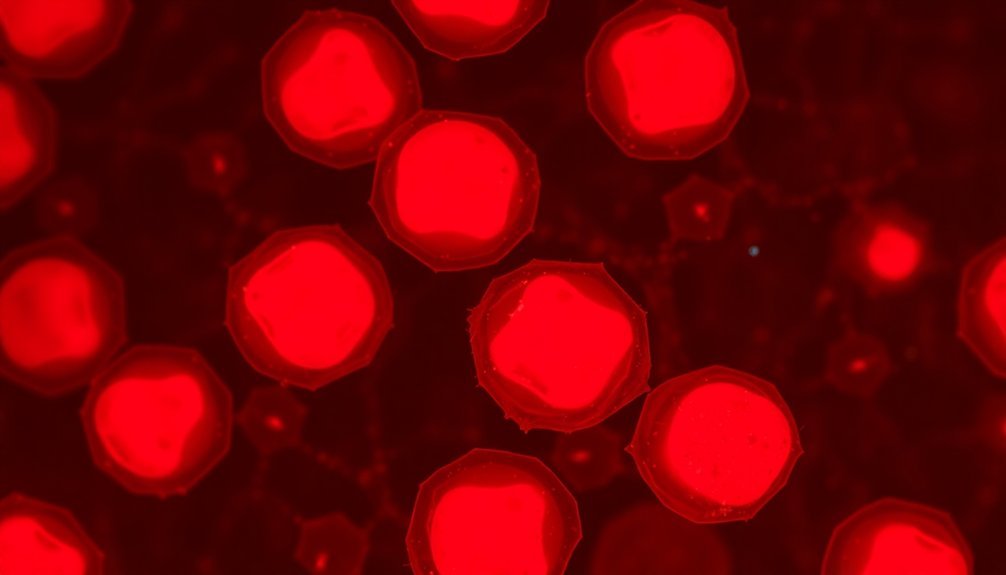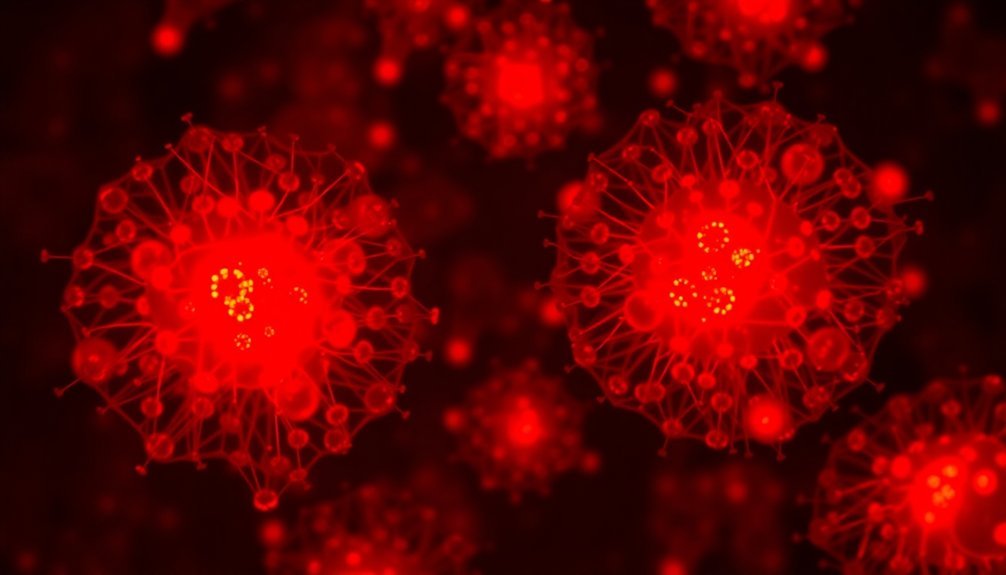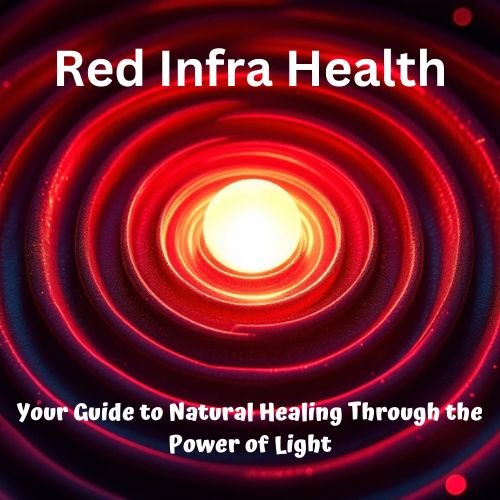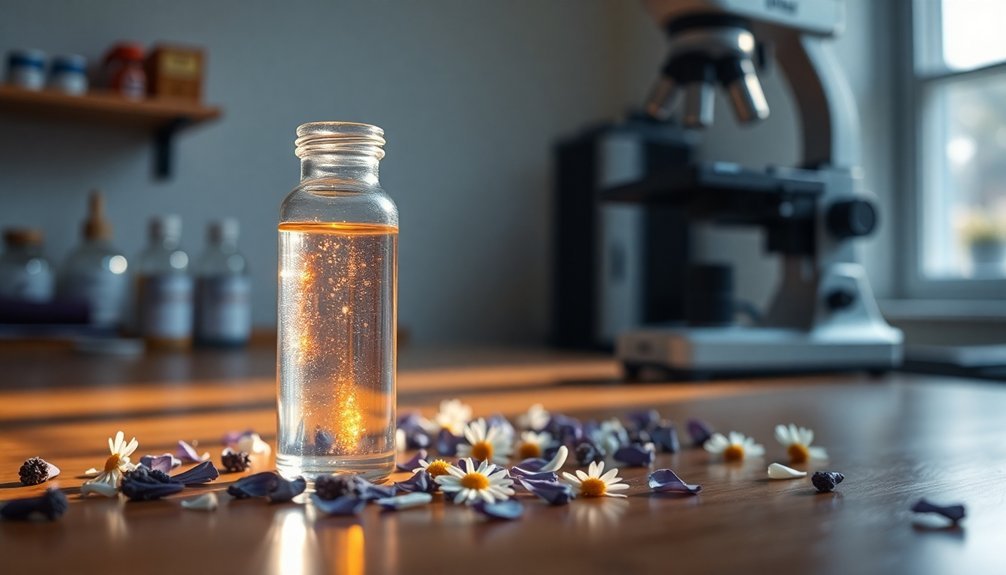Red wavelengths between 620-850nm directly enhance your testosterone production through multiple pathways. The light stimulates your Leydig cells, which are specialized cells in your testes responsible for testosterone synthesis. When these wavelengths penetrate your testicular tissue, they trigger increased mitochondrial activity and ATP production, providing more cellular energy for hormone production. This boost in energy allows your Leydig cells to convert cholesterol into testosterone more efficiently through the steroidogenic pathway. The process also optimizes your cellular signaling and protects against oxidative damage. Understanding these mechanisms can reveal even more benefits for your hormonal health.
Stimulation of Leydig Cells

The stimulation of Leydig cells plays a crucial role in testosterone production through complex cellular and molecular mechanisms. Your body's Leydig cells rely on specific enzymes like CYP11A1, HSD3B1, CYP17A1, and HSD17B3 to produce testosterone, while the StAR protein facilitates essential cholesterol transport into mitochondria.
You'll find that light exposure substantially impacts Leydig cell function and testosterone synthesis. Research shows that green LED light, when combined with 3D scaffolds, can boost Leydig cell proliferation and enhance testosterone-related gene expression. Morning exposure to bright light can synchronize your circadian rhythm and optimize testosterone production.
However, you should note that constant light exposure can disrupt normal endocrine function and slow Leydig cell maturation.
If you're dealing with testosterone deficiency, emerging therapeutic approaches offer promising solutions. Scientists have successfully used stem Leydig cell transplantation to restore testosterone production in various models.
This technique can increase your serum testosterone levels, recover spermatogenesis, and improve testosterone deficiency symptoms. The cells can differentiate and proliferate, potentially providing you with a long-lasting, physiological solution for testosterone replacement that works with your body's natural processes.
Enhanced ATP Production
Building on the role of Leydig cells, ATP production stands at the heart of efficient testosterone synthesis. When you expose your body to red light therapy, particularly at wavelengths of 660 nm and 850 nm, you're directly stimulating your mitochondria to produce more ATP, which serves as your cells' primary energy source. This enhanced cellular energy system is further supported by seminiferous tubules' metabolism.
This enhanced ATP production energizes your Leydig cells, powering the complex process of steroidogenesis where cholesterol transforms into testosterone. You'll find that red light therapy stimulates the respiratory chain in your mitochondria, creating a surge of cellular energy that's essential for testosterone production.
The benefits extend beyond just hormone production. You're also improving your sperm quality and reducing oxidative stress throughout your body. When you undergo red light therapy, you're activating specific photoreceptors in your Leydig cells that boost testosterone synthesis while simultaneously enhancing overall cellular function.
Research shows that consistent red light therapy sessions can lead to sustained increases in testosterone levels. You'll get the best results from whole-body treatment, as it maximizes ATP production across all your tissues and supports extensive hormonal health.
Mitochondrial Function Optimization

Optimizing mitochondrial function dramatically enhances your body's testosterone production capabilities through several key mechanisms. Your mitochondria serve as the powerhouses of Leydig cells, which are directly responsible for testosterone production. When these cellular components work at peak efficiency, they create an ideal environment for hormone synthesis and regulation.
Proper mitochondrial function relies heavily on both lifestyle factors and hormonal balance. Your exercise routine, particularly resistance training, stimulates mitochondrial biogenesis, while a diet rich in healthy fats supports ongoing mitochondrial health. Green tea and fruits provide critical antioxidant protection for your mitochondria.
If you're looking to maximize testosterone production, you'll want to focus on supplements that support mitochondrial function, such as CoQ10, alpha-lipoic acid, and acetyl-L-carnitine.
Your body's stress response actually triggers mitochondrial adaptation in Leydig cells, showing how these organelles actively respond to environmental demands. When your mitochondria are functioning ideally, they create a positive feedback loop – better mitochondrial function leads to increased testosterone production, which in turn supports further mitochondrial health.
This synergistic relationship is vital for maintaining both cellular energy production and hormone synthesis.
Photoreceptor Activation Mechanisms
Understanding photoreceptor activation reveals a fascinating link between light exposure and testosterone production in your body. Your eyes contain specialized photoreceptors, including melanopsin, that respond specifically to red wavelengths. These photoreceptors don't just help you see; they're instrumental in regulating your circadian rhythms and hormonal balance.
When red light hits these photoreceptors, it triggers a complex cascade of cellular responses that can influence your testosterone levels. This process involves your hypothalamic-pituitary-gonadal (HPG) axis, which controls testosterone production through hormones like GnRH and LH. The red light exposure may enhance the function of this crucial hormone regulation system. Research demonstrates that Src kinase activation occurs rapidly within one minute of stimulation.
Your body's response to red light involves sophisticated cellular signaling pathways, including MAPK and cAMP/PKA systems. These pathways interact with androgen receptors and activate important transcription factors like CREB.
While scientists are still investigating the exact mechanisms, research suggests that red light therapy could optimize these pathways, potentially boosting your testosterone production. The interaction between photoreceptors and your endocrine system demonstrates how light exposure can influence your hormonal health through multiple, interconnected biological mechanisms.
Cellular Energy Transformation

Beyond photoreceptor activation, red light therapy's impact on testosterone production centers on cellular energy transformation within your body's Leydig cells. These specialized cells rely heavily on mitochondrial energy to produce testosterone, and their function depends on specific enzymes like cholesterol side-chain cleavage enzyme and proton-translocating ATPases.
When you're exposed to red light therapy, it enhances your mitochondrial function, particularly the Atp5a1 enzyme that's essential for testosterone synthesis. This is especially important because chronic stress and other factors can damage mitochondrial structure in Leydig cells, leading to decreased testosterone production.
Your body's cellular energy pathways directly influence how effectively you can produce testosterone, affecting everything from carbohydrate metabolism to insulin sensitivity.
If you're dealing with testosterone deficiency, it's often linked to impaired glucose tolerance and metabolic issues. The good news is that by improving cellular energy transformation through red light therapy, you're supporting your body's natural testosterone production mechanisms.
This process works alongside your body's antioxidant systems, helping to protect Leydig cells from oxidative damage and maintain ideal testosterone synthesis conditions.
Frequently Asked Questions
How Long Does It Take to See Measurable Testosterone Increases From Red Light Therapy?
You'll typically notice measurable testosterone increases within several weeks of starting red light therapy, but your results may vary. Keep consistent with 10-20 minute sessions, 3-4 times weekly for maximum benefits.
Can Red Light Therapy Help Reverse Age-Related Testosterone Decline?
Yes, you can counteract age-related testosterone decline with red light therapy. Regular sessions boost your Leydig cells' ability to produce testosterone, helping restore more youthful hormone levels when used consistently over time.
What Body Areas Should Be Targeted for Maximum Testosterone Production Benefits?
You'll want to target your testicles primarily, as they contain Leydig cells that produce testosterone. Also focus on your lower abdomen and adrenal area. Keep sessions brief and use recommended wavelengths of 600-950nm.
Does Time of Day Affect Red Light Therapy's Effectiveness for Testosterone Production?
While there's no conclusive evidence that time of day affects red light therapy's testosterone benefits, you'll likely get the best results by maintaining consistent timing and following recommended session durations of 10-20 minutes.
Can Certain Medications Interfere With Red Light Therapy's Testosterone-Boosting Effects?
Yes, certain medications can interfere with red light therapy's testosterone effects. You'll need to be cautious if you're taking opioids, corticosteroids, antidepressants, or blood pressure medications. Always consult your healthcare provider first.
In Summary
You'll notice significant improvements in your testosterone levels by incorporating red light therapy into your routine. The stimulation of your Leydig cells and enhanced ATP production work together to optimize your hormonal health. Through targeted exposure to red wavelengths, you're activating essential cellular mechanisms that boost testosterone production. It's a natural, effective way to support your body's hormone synthesis process.





Leave a Reply